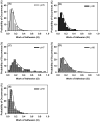The role of the pH conditions of growth on the bioadhesion of individual and lawns of pathogenic Listeria monocytogenes cells
- PMID: 21459385
- PMCID: PMC3081937
- DOI: 10.1016/j.jcis.2011.03.025
The role of the pH conditions of growth on the bioadhesion of individual and lawns of pathogenic Listeria monocytogenes cells
Abstract
The work of adhesion that governs the interactions between pathogenic Listeria monocytogenes and silicon nitride in water was probed for individual cells using atomic force microscopy and for lawns of cells using contact angle measurements combined with a thermodynamic-based harmonic mean model. The work of adhesion was probed for cells cultured under variable pH conditions of growth that ranged from pH 5 to pH 9. Our results indicated that L. monocytogenes cells survived and adapted well to the chemical stresses applied. For all pH conditions investigated, a transition was observed in the generation time, physiochemical properties, biopolymer grafting density and bioadhesion for cells cultured in media adjusted to pH 7 of growth. In media with pH 7, the generation time for the bacterial cells was lowest, the specific growth rate constant was highest, the cells were the most polar, cells displayed the highest grafting density of surface biopolymers and the highest bioadhesion to silicon nitride in water represented in terms of the work of adhesion. When compared, the work of adhesion values quantified between silicon nitride and lawns of L. monocytogenes cells were linearly correlated with the work of adhesion values quantified between silicon nitride and individual L. monocytogenes cells.
Published by Elsevier Inc.
Figures






Similar articles
-
Force-Averaging DLVO Model Predictions of the Adhesion Strengths Quantified for Pathogenic Listeria monocytogenes EGDe Grown under Variable pH Stresses.Langmuir. 2020 Aug 4;36(30):8947-8964. doi: 10.1021/acs.langmuir.0c01500. Epub 2020 Jul 24. Langmuir. 2020. PMID: 32633976
-
Impact of ionic strength of growth on the physiochemical properties, structure, and adhesion of Listeria monocytogenes polyelectrolyte brushes to a silicon nitride surface in water.J Colloid Interface Sci. 2012 Dec 15;388(1):257-67. doi: 10.1016/j.jcis.2012.08.048. Epub 2012 Sep 1. J Colloid Interface Sci. 2012. PMID: 23010316
-
The role of growth temperature in the adhesion and mechanics of pathogenic L. monocytogenes: an AFM study.Langmuir. 2012 Jan 17;28(2):1360-73. doi: 10.1021/la203639k. Epub 2011 Dec 19. Langmuir. 2012. PMID: 22133148
-
A correlation between the virulence and the adhesion of Listeria monocytogenes to silicon nitride: an atomic force microscopy study.Colloids Surf B Biointerfaces. 2009 Oct 15;73(2):237-43. doi: 10.1016/j.colsurfb.2009.05.027. Epub 2009 Jun 6. Colloids Surf B Biointerfaces. 2009. PMID: 19576735
-
Combined Poisson and soft-particle DLVO analysis of the specific and nonspecific adhesion forces measured between L. monocytogenes grown at various temperatures and silicon nitride.Environ Sci Technol. 2012 Sep 18;46(18):10089-98. doi: 10.1021/es300653w. Epub 2012 Sep 4. Environ Sci Technol. 2012. PMID: 22917240
Cited by
-
Effects of Nanopillar Size and Spacing on Mechanical Perturbation and Bactericidal Killing Efficiency.Nanomaterials (Basel). 2021 Sep 22;11(10):2472. doi: 10.3390/nano11102472. Nanomaterials (Basel). 2021. PMID: 34684913 Free PMC article.
-
Roles of ionic strength and biofilm roughness on adhesion kinetics of Escherichia coli onto groundwater biofilm grown on PVC surfaces.Water Res. 2013 May 1;47(7):2531-42. doi: 10.1016/j.watres.2013.02.032. Epub 2013 Feb 26. Water Res. 2013. PMID: 23497979 Free PMC article.
-
Quantitatively predicting bacterial adhesion using surface free energy determined with a spectrophotometric method.Environ Sci Technol. 2015 May 19;49(10):6164-71. doi: 10.1021/es5050425. Epub 2015 May 4. Environ Sci Technol. 2015. PMID: 25898026 Free PMC article.
-
Changes in Cellular Elasticities and Conformational Properties of Bacterial Surface Biopolymers of Multidrug-Resistant Escherichia coli (MDR-E. coli) Strains in Response to Ampicillin.Cell Surf. 2019 Dec;5:100019. doi: 10.1016/j.tcsw.2019.100019. Epub 2019 Mar 4. Cell Surf. 2019. PMID: 31179402 Free PMC article.
-
The Effects of β-Lactam Antibiotics on Surface Modifications of Multidrug-Resistant Escherichia coli: A Multiscale Approach.Microsc Microanal. 2019 Feb;25(1):135-150. doi: 10.1017/S1431927618015696. Microsc Microanal. 2019. PMID: 30869575 Free PMC article.
References
-
- Schlech WF. Pathogenesis and immunology of Listeria monocytogenes. Pathologie Biologie. 1996;44(9):775–782. - PubMed
-
- Aarnisalo K, Autio T, Sjoberg AM, Lunden J, Korkeala H, Suihko ML. Typing of Listeria monocytogenes isolates originating from the food processing industry with automated ribotyping and pulsed-field gel electrophoresis. Journal of Food Protection. 2003;66(2):249–255. - PubMed
-
- Vasseur C, Rigaud N, Hebraud M, Labadie J. Combined effects of NaCl, NaOH, and biocides (monolaurin or lauric acid) on inactivation of Listeria monocytogenes and Pseudomonas spp. Journal of Food Protection. 2001;64(9):1442–1445. - PubMed
-
- Bouttefroy A, Mansour M, Linder M, Milliere JB. Inhibitory combinations of nisin, sodium chloride, and pH on Listeria monocytogenes ATCC 15313 in broth by an experimental design approach. International Journal of Food Microbiology. 2000;54(1–2):109–115. - PubMed
Publication types
MeSH terms
Substances
Grants and funding
LinkOut - more resources
Full Text Sources

